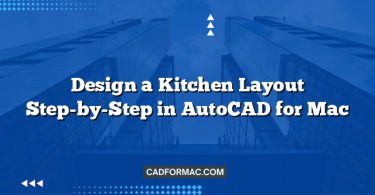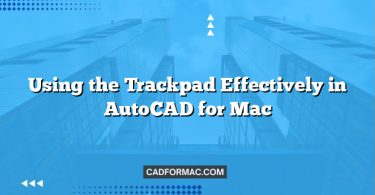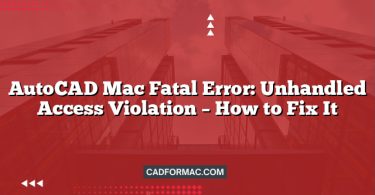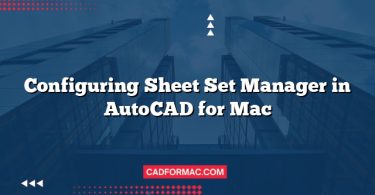AutoCAD for Mac has long been a powerful tool for architects, engineers, and designers—but until recently, automating repetitive tasks required scripting knowledge or third-party plugins. With the introduction of Apple Shortcuts (formerly Workflow) and tighter macOS integration, users can now streamline their AutoCAD workflows using native automation tools. While AutoCAD for Mac doesn’t offer deep native Shortcuts integration like some Apple apps, creative use of system-level actions, file handling, and URL schemes can significantly boost productivity.
This guide explores practical ways to combine Apple Shortcuts with AutoCAD for Mac to automate file management, launch commands, and simplify daily routines.
Understanding the Limitations
Before diving in, it’s important to acknowledge the current limitations:
- No native Shortcuts actions: AutoCAD for Mac doesn’t provide built-in Shortcuts actions (as of AutoCAD 2024).
- Limited AppleScript support: While AutoCAD supports AppleScript to some degree, it’s not as robust as in fully Apple-integrated apps.
- No direct command execution: You can’t directly trigger AutoCAD drawing commands (e.g., “LINE” or “TRIM”) from a Shortcut.
However, you can automate surrounding tasks—file handling, launching AutoCAD with specific files, batch processing via scripts, and integrating with cloud services. These indirect automations still save significant time.
Practical Automation Ideas
1. Quickly Open Recent or Template Drawings
Create a Shortcut that opens your most-used templates or recent drawings with a single click or voice command.
Steps:
- Open the Shortcuts app.
- Create a new shortcut.
- Add the “Open URLs” action.
- Enter the file path using the
file://scheme (e.g.,file:///Users/yourname/Documents/AutoCAD/Templates/Architectural.dwt). - Optionally, add a “Open in App” action and select AutoCAD.
Tip: Use the “Choose from Menu” action to let users pick from multiple templates.
2. Batch Rename and Organize DWG Files
Use Shortcuts to rename, move, or tag DWG files based on project names or dates.
Example Shortcut:
- Get files from a folder (e.g., “Downloads”).
- Filter by
.dwgextension. - Rename using a format like
ProjectName_YYYYMMDD.dwg. - Move to a designated project folder.
This is especially useful after receiving files from collaborators or exporting from other software.
3. Auto-Backup Current Drawing
While AutoCAD has autosave, you can create a Shortcut that copies the active drawing to a backup folder with a timestamp.
How it works:
- Use a folder action or manual trigger.
- Get the frontmost AutoCAD document path (requires AppleScript—see below).
- Copy the file to a “Backups” folder with a date suffix.
AppleScript snippet (used within a “Run AppleScript” action):
tell application "AutoCAD"
set currentDoc to full name of active document
end tell
Then pass currentDoc to a “Copy File” action in Shortcuts.
Note: AppleScript access must be enabled in System Settings > Privacy & Security > Automation.
4. Launch AutoCAD with a Specific Script
AutoCAD supports running scripts (.scr files) at startup using command-line arguments. You can automate this via Shortcuts.
Shortcut Setup:
- Use the “Run Shell Script” action.
- Enter:
open -a "AutoCAD" --args /path/to/your/script.scr - Save and run.
This is ideal for standardizing drawing setups (layers, units, title blocks) across projects.
5. Integrate with Cloud Services
Automate syncing DWG files to iCloud, Dropbox, or OneDrive after saving.
Example Flow:
- Trigger after saving a file (manual or folder-based).
- Upload the file to your cloud service using built-in Shortcuts actions.
- Send a notification when complete.
This ensures your work is backed up and accessible across devices.
Advanced: Combining Shortcuts with AutoLISP
For power users, combine Apple Shortcuts with AutoLISP routines:
- Save a common AutoLISP routine (e.g.,
cleanup.lsp) in a known location. - Create a script file (
run_cleanup.scr) that loads and runs it:(load "cleanup.lsp") (cleanup) - Use a Shortcut to launch AutoCAD with this script (as in Idea #4).
Now, a single tap runs your custom cleanup routine on any drawing.
Tips for Success
- Use consistent file naming: Automation works best with predictable file structures.
- Enable Full Disk Access: Go to System Settings > Privacy & Security > Full Disk Access and grant permission to Shortcuts if accessing protected folders.
- Test incrementally: Build and test each Shortcut step-by-step to isolate issues.
- Leverage Siri: Assign voice phrases like “Open architectural template” for hands-free access.
FAQ: Apple Shortcuts and AutoCAD for Mac
Q1: Can I trigger AutoCAD drawing commands (like LINE or CIRCLE) directly from an Apple Shortcut?
A: No. Apple Shortcuts cannot send native AutoCAD commands to the application. AutoCAD for Mac does not expose its command engine to Shortcuts or AppleScript in a way that allows direct execution of drawing tools. Automation is limited to file operations, app launching, and running pre-written scripts or LISP routines.
Q2: Does AutoCAD for Mac support URL schemes that Shortcuts can use (like autocad://open/file.dwg)?
A: As of AutoCAD 2024, AutoCAD for Mac does not register a custom URL scheme (e.g., autocad://). This means you cannot use URL-based deep linking to open files or trigger actions from Shortcuts. Instead, use the file:// protocol with the Open URLs action or the open -a "AutoCAD" shell command.
Q3: Why doesn’t my “Run AppleScript” action in Shortcuts work with AutoCAD?
A: macOS requires explicit user permission for apps to control other applications via AppleScript. Go to System Settings > Privacy & Security > Automation, and ensure both Shortcuts and Script Editor (if used) have permission to control AutoCAD. Also, verify that your AppleScript syntax matches AutoCAD’s AppleScript dictionary (accessible via Script Editor > File > Open Dictionary).
Q4: Can I automate printing or exporting PDFs from AutoCAD using Shortcuts?
A: Not directly. AutoCAD’s print/export functions aren’t accessible via Shortcuts or AppleScript in a reliable way. However, you can automate the preparation step: use a Shortcut to open a drawing with a script that runs a PLOT or EXPORTPDF command (if defined in a .scr or .lsp file). The actual export still happens inside AutoCAD after launch.
Q5: Will these Shortcuts work on Apple Silicon Macs (M1/M2/M3)?
A: Yes—if AutoCAD for Mac is running natively or via Rosetta 2 (which it currently does). Apple Shortcuts is fully supported on Apple Silicon, and file-based or shell-script automations are architecture-agnostic. Just ensure file paths and app names match your system (e.g., AutoCAD is installed in /Applications).
Q6: Can I use Shortcuts to batch process multiple DWG files (e.g., convert all to PDF)?
A: Only indirectly. You’d need to create an AutoLISP routine or script that processes one file, then use a shell script (called from Shortcuts) to loop through files and launch AutoCAD repeatedly with that script. This is complex and slow, as AutoCAD must start/quit for each file. For true batch processing, consider AutoCAD’s ScriptPro (Windows-only) or third-party tools.
Q7: Do Shortcuts work with AutoCAD LT for Mac?
A: Partially. AutoCAD LT for Mac supports fewer automation features than full AutoCAD—it lacks AutoLISP and advanced scripting. You can still use Shortcuts for file management (e.g., opening .dwg files), but you cannot run .lsp or complex .scr files. Always test your workflow with LT’s limitations in mind.
Q8: Can I add AutoCAD actions to the Shortcuts menu in Finder or the menu bar?
A: Yes! After creating a Shortcut that operates on files (e.g., “Backup DWG”), enable “Show in Share Sheet” or “Pin to Menu Bar” in the Shortcut’s settings. You can then right-click a .dwg file in Finder and run your automation directly—ideal for quick backups or renaming.
Conclusion
While AutoCAD for Mac doesn’t yet offer deep native integration with Apple Shortcuts, clever use of file actions, AppleScript, shell commands, and cloud services can automate many tedious aspects of your workflow. From launching templated drawings to backing up files and running scripts, these automations reduce clicks, minimize errors, and free you to focus on design—not drudgery.
As Apple continues to expand Shortcuts’ capabilities—and Autodesk potentially adds deeper macOS integration—the possibilities will only grow. Start small, experiment, and build a library of Shortcuts tailored to your unique AutoCAD workflow.




